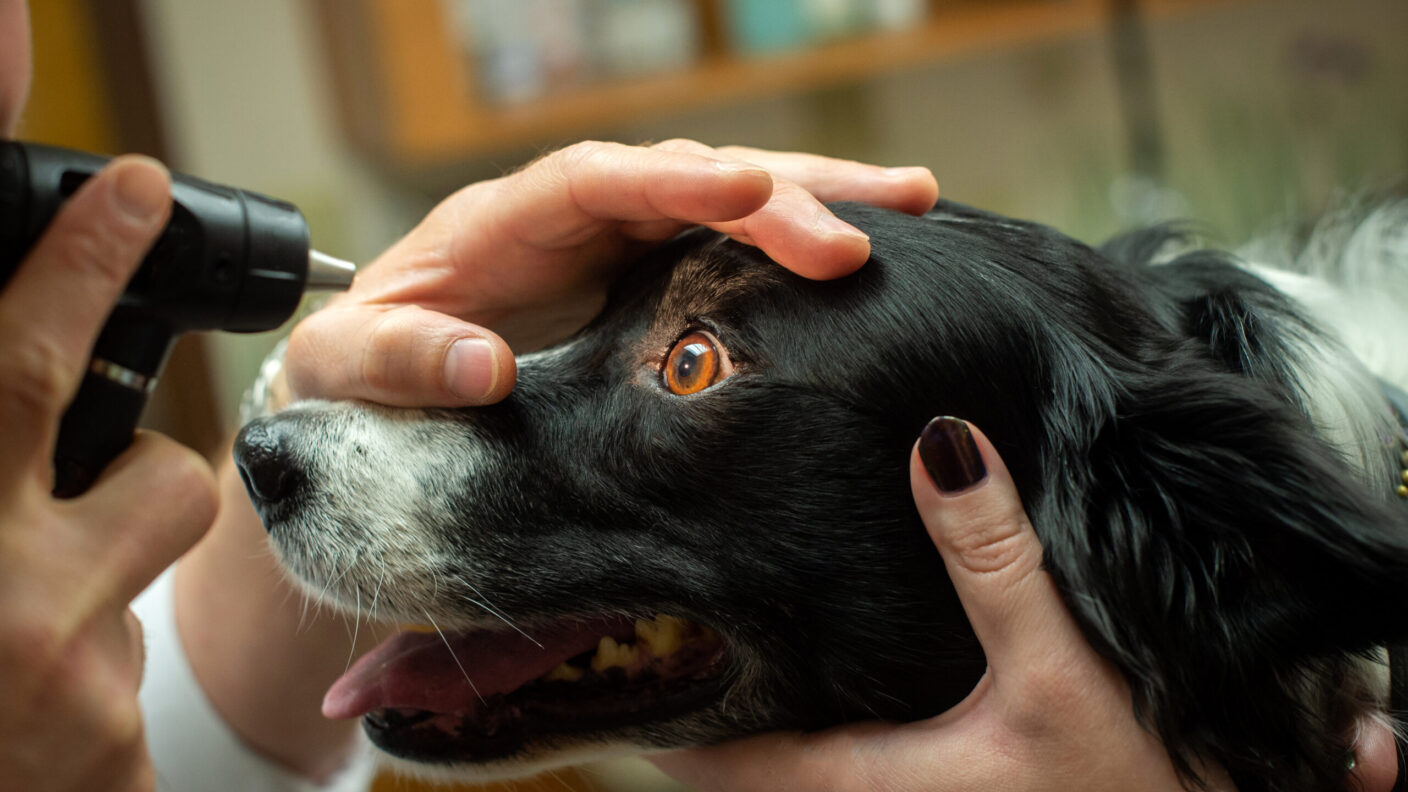Five Things To Know About Canine Glaucoma As A Pet Owner
Texas A&M veterinary ophthalmologist explains symptoms, treatments and why dogs can maintain a high quality of life even after losing vision to this common eye condition.

A veterinarian examines a dog’s eyes for signs of glaucoma. Early detection and treatment can help manage the condition that affects canine vision and comfort.
As a dog owner, one of your most important responsibilities is keeping watch over your pet’s health — including their eyes. Staying vigilant can help you recognize the signs of serious medical conditions so that your furry friend can get help when they need it.
One thing to keep a lookout for is canine glaucoma, a condition that occurs when the eye cannot drain fluid properly and begins to build pressure. While glaucoma is considered a serious health condition, many dogs have a high quality of life post-treatment, continuing to enjoy their favorite activities.
To help separate fact from fiction, Dr. Sean Collins, a clinical assistant professor and ophthalmology specialist at the Texas A&M College of Veterinary Medicine and Biomedical Sciences, shares five things that pet owners should know about canine glaucoma.
Humans And Dogs Both Get Glaucoma
Glaucoma is something you may have heard about from a human eye doctor, and that’s because both humans and dogs can develop this condition.
“Glaucoma is currently the most common cause of blindness in our canine patients,” Collins said.
However, the diagnosis requirements for dogs is a little different than it is in humans.
“In dogs, we look for elevation in intraocular pressure that results in damage to the retina and optic nerve,” he said. “Humans often have increased intraocular pressure, too, but it’s not required for a diagnosis.”
There Are Two Kinds Of Glaucoma
There are two main types of glaucoma in dogs — the first is caused by a genetic predisposition and the second happens when a dog has another condition that triggers the glaucoma.
“For secondary glaucoma, some of the possible causes are retinal detachments, inflammation, tumors, lens instability and infectious diseases,” Collins said. “With primary glaucoma — the genetic type — there are certain breeds that are more at risk, including cocker spaniels, beagles, basset hounds, Boston terriers, French bulldogs and many others.”
Watch For Signs Of Glaucoma
While dogs tend to hide their distress, there are symptoms of glaucoma that owners can keep a lookout for.
“The white part of the eye will often turn beet red,” Collins said. “The cornea, which is the transparent layer that sits over the pupil and iris, will often turn cloudy blue. We also expect the pupil to be dilated, though that is not always the case.
“Typically, dogs will also show signs of being in pain and discomfort,” he said. “They may squint, or they may shut their eye and paw at it, sometimes even vocalizing that they are in distress.”
If you suspect that your dog may have glaucoma, the best thing to do is take them to your local veterinarian who can check their intraocular pressure and recommend a specialist for treatment if necessary.
There Are Multiple Treatment Options
If your dog is diagnosed with glaucoma, your veterinarian will recommend one of several things, depending on the progression of the disease and the level of discomfort it’s causing.
“One of the first steps is to use topical anti-glaucoma treatments, like eyedrops, that help regulate intraocular pressure,” Collins said. “Typically, a patient will use them until they lose sight in the affected eye and the intraocular pressure cannot be controlled. After that point, your veterinarian may recommend surgery to remove the eye, and they may suggest surgery earlier if your dog’s glaucoma isn’t responding to medication.
“With glaucoma, one of the main priorities for improving patient quality of life is removing the pain,” he said. “By human standards, the pressure from glaucoma can feel like anything from a headache to an intense migraine, and we do know that dogs have similar pain receptors in their eyes.”
Glaucoma Doesn’t Stop Dogs From Enjoying Life
While it’s normal to be worried if your dog is diagnosed with glaucoma, it’s important to know that treatment can help your dog continue living a happy, heathy life — and that includes dogs who have an eye removed as part of their treatment.
“Many dogs that have an eye removed behave almost like puppies again because they’re so excited to be pain-free,” Collins said. “Prior to treatment, many dogs will mask their pain because they don’t want to show weakness, so there is often a very noticeable — and positive — change in attitude and quality of life afterward.
“Dogs with only one eye or even no eyes adapt very well,” he said. “As long as they’re pain-free, we believe all glaucoma patients can have a great quality of life.”
